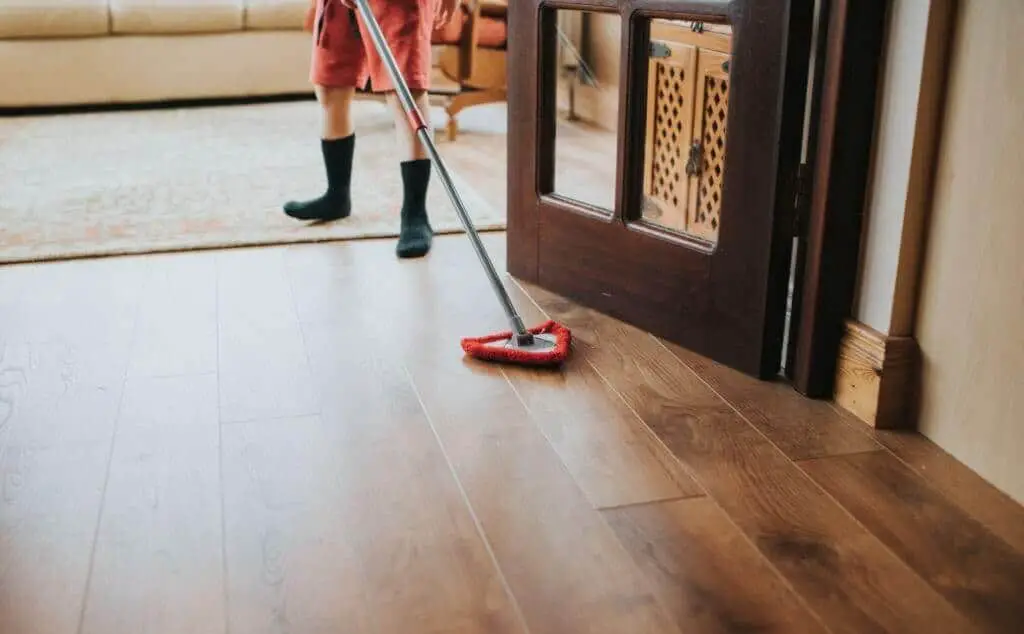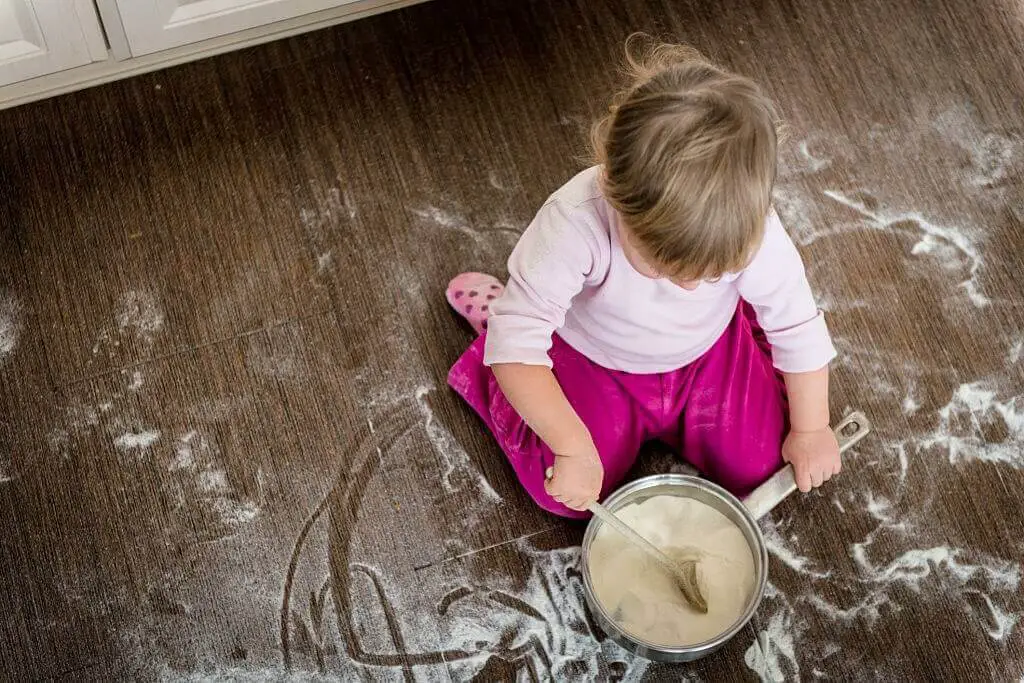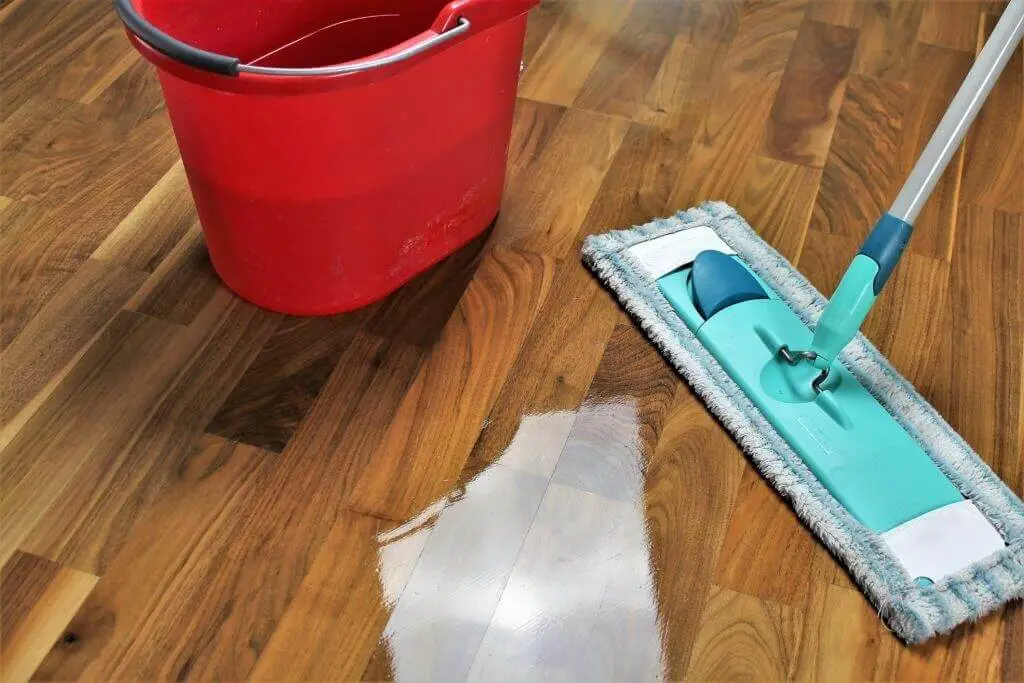When cleaning your floors, you are expectant of a clean and nice-smelling result. It’s quite frustrating to end up with a sticky floor even after cleaning, or a floor that leaves ashy imprints when walked upon.
The best route around this is to find out the perfect guide on how to clean sticky wood floors. That said, we’ve got you covered. Walking on such floor results to a slapping sounds like a tape being pulled from its roll, this can be quite an eyesore.
Sticky floors are more common than you think; it happens on every floor type. Perhaps, you have the right cleaning products; you could still end up with a sticky wood floor if you are not following the right procedure. Well, there are a couple of reasons why your floor is still sticky, even after hours of cleaning.
Causes of Sticky Wood Floors
Sticky floors occur when you use too much leaving agent, wrong cleaning agent, or use the wrong cleaning technique for your floor, as every floor has its different cleaning technique.
It could be due to the usage of dirty water when cleaning, or a result of spillage of drinks, grease, salt, or glue on the floor.
Read: Easy Homemade Floor Cleaner
Residue Buildup
The residue left behind from the spillage of drinks, glue on the floor is hard to clean; it requires multiple cleaning.
Also, in places like the kitchen, grease from pots and pans may get into the air and onto the floor. Accumulation of this grease and other chemicals may lead to a sticky floor.
Using the Wrong Cleaning Agents
The type of cleaning chemical you need depends on the type of floor and stain you are dealing with; using the wrong chemical may remove the stain, but it won’t remove the stickiness.
When getting a cleaning agent, be sure to ask for a solution suitable for your floor type and stain, not only does getting the right cleaning agent helps to prevent and remove stickiness but using the wrong solution on the floor could damage it.
The PH of a cleaning solution is what removes stains from a surface; if dealing with an acidic stain, you will need an alkaline cleaning solution to remove it without causing stickiness. Likewise, an alkaline stain will need an acidic solution.
Using Too Much Cleaning Solution
You might want to limit the amount of cleaning agents you use. Using a lot of cleaning solution does not lead to a cleaner floor, you only end up with a sticky mess of a floor.
You need to follow the instructions on the label of your cleaning solution. When used wrongly or in high quantity, a heavy soapy residue is left behind, resulting in a sticky floor.
Using a dilution station will help to combat this problem as most cleaning solutions are very concentrated and quite difficult to measure the correct amount.
With a push of a button, the dilution station mixes water and cleaning agents, giving you the right concentration saving you the stress and unnecessary time consuming multiple cleaning.
Nowadays, most cleaning solutions come with measuring caps, so you should use the recommended amount of cleaning agent and water stated on the instruction label.
Cleaning With Dirty Water
When cleaning, you start with a clean bucket of water, but the water gets dirty as you cover more ground.
The mop picks up debris and dirt and dumps them into the water, and if you should clean the entire house with the same bucket of water, you guessed right! You’ll end up with a stickier and dirtier floor because you are basically transferring dirt from one corner to the other on the floor.
Read: Best mop Bucket
You can rinse the floor with some clean water, but that won’t work well, why? Because the dirt is meant to be removed by the chemicals in cleaning agent
Whenever there’s a significant change in the color of the cleaning water or a lot of debris floating on top or at the bottom of the water, it needs to be changed.
This applies to the water used in rinsing; once it becomes soapy or colored, it needs to be changed, or to save yourself this whole process, you could go for a mop bucket that keeps the clean and dirty water separate.
Another great tool is the automatic scrubber that scrubs the floor while simultaneously applying a cleaning solution and then vacuum up the dirty water.
Another better option is the microfiber mops; they are a great alternative to good ol’traditional mops. The microfiber mops hold onto much more dirt effectively, and this means that they will not release the dirt and debris into the water, which makes it dirty.
How to Clean Sticky Wood Floors
Ending up with sticky floors can be overwhelming. There are a couple of tips you can put into action to make a substantial improvement in your cleaning regiment.
Firstly, you have to narrow down the cause of the stickiness; you may have to change your cleaning techniques and tools and chemicals; this will eventually help you in the long run.
Once you get a technique and chemical that works well for your sticky floor, you should stick to that and not fall back into old habits.
If you are struggling with a sticky floor, there are easy remedies that need a little knowledge and cleaning know-how. Battling sticky floor uses up valuable time and not to mention that they can also ruin your floor.
Read: How to clean bamboo floor
Choose Residue-Free or Less-Residue Cleaners
A very sure and easy way to make sure residues don’t buildup or accumulate on your floors again is to use a residue-free or low residue cleaner. Unfortunately, some self-acclaimed “residue-free” cleaners still leave behind a film.
So an easy test you could do to see how much residue a cleaner will leave behind is to simply spray the cleaner on some glass and wipe it away, you will get to see if it leaves behind any film.
You have to note that not all residue-free cleaning solutions are the same. So you have to keep yourself abreast with some knowledge regarding cleaning chemicals, so you know what to buy and what to avoid.
For sticky hardwood floor, an ammonia-free solution can come in handy, all you’ve to do is, spray some of the solutions on your floor and let it sit for about two to three minutes, then using a wet sponge, scrub the area of the floor where you sprayed the cleaner vigorously.
After which you can wipe the floor with a damp towel, repeat these steps till the floor is residue-free.
Using the Right Cleaner Concentration
Using the right cleaner concentration could make or break your cleaning results. Although it is more pocket-friendly to buy very concentrated cleaning products as opposed to ready to use ones, as when you dilute it, you get more product.
But getting the right dilution could be a problem, and using the wrong concentration could lead to more residue problems. Make sure to follow the manufacturer’s recommendation on the label.
Using a Steam Mop
Using a steam mop is a surefire way to get rid of your sticky floor, it uses vaporized water, killing harmful microorganisms on the floor.
You don’t have to rinse your floor with clean water again, as you would do with regular mopping when using a steam mop.
On the downside, you have to make sure it is suitable for your floor type before using the steam mop as it could ruin your floor finishing.
Read: Best Steam Mop
Cleaning According to Floor Type
Every floor type has its cleaning technique, so know the method that works for your floor and stick to it. When dealing with wood, make sure to use a soft cloth or a mop to get dirt and duct from the floor.
You have to be careful of things that could scratch the floor, like a vacuum cleaner, and it would be best to place a decorative accessory like a rug or furniture in high traffic areas to reduce scratches, which may eventually ruin the floor.
For the tile floor, you need to sweep before cleaning and make sure to use a mild detergent and clean water. Enjoy a clean grout by creating a natural disinfectant withy vinegar and baking soda, allow it to sit for 15 minutes, then wipe clean.
For vinyl floors, always try to sweep with a broom daily and always choose a no-wax vinyl cleaner. Avoid soaking your vinyl floor in too much water, causing cracks and the corners to curl.
Lastly, we have an easy step by step cleaning method to remove the sticky floor if it is caused by spilled soda, oil, or salt.
Tools you will need:
- Water
- Mop
- Damp rag/towel
- Vinegar
Method
- Firstly fill a bucket with water, then add a very generous amount of vinegar into the bucket of water.
- Soak your mop in the mixture and let it sit for some minutes
- Take your mop out of the bucket, place it directly on the area of the floor with the residue, then let it sit for at least 10 minutes, this is to soften the residue.
- Then using the mop, clean the areas vigorously.
- Wipe the mopped area with the damp towel or rag.
- You may need to repeat this process as much as necessary, tilled the whole area is covered and your floor ids residue-free
Conclusion
When finding how to fix sticky wood floors, the first thing to do is to determine the cause. If you are using too many chemicals, reduce it, and if you are using the wrong chemical, change it to the right one.
If it’s due to the wrong cleaning technique, change to the right one, and always use clean water when mopping. For a flawless cleanup, ensure to change the water once it gets noticeably dirty.
Following this information we have provided you with will help you get rid of the sticky floor and also help prevent it in the future. Are you experiencing sticky wood floors? What method did you use to tackle it?


